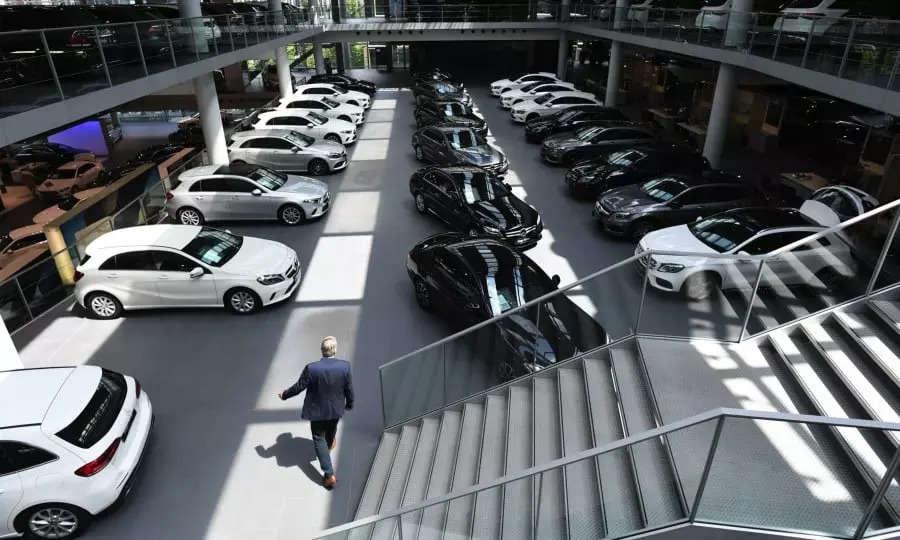
New Delhi: Vehicle retail sales in the country in November 2023 witnessed a YoY growth of 18% and MoM growth of 35% at 28.54 lakh vehicles. While 2W, 3W, and PV showed growth of 21%, 23%, and 17% respectively on a YoY basis, tractors and CVs fell by 21% and 2% YoY, according the data for the month released by the Federation of Automobile Dealers Associations (FADA) on Wednesday,About the November 2023 Auto Retails, FADA President, Manish Raj Singhania, said, “November 2023 has become a historic month for the Indian Auto Retail Industry as during the month, 28.54 lakh vehicles were sold, thus overtaking the previous highs of March’20 when the industry sold 25.69 lakh vehicles during the BS-4 to BS-6 transition. Apart from this, 2W and PV also created new records. The 2W category sold 22.47 lakh vehicles, an increase of 1.77 lakh vehicles compared to the previous high of March 2020. The PV category also sold 3.6 lakh vehicles, ~4K vehicles more than from the previous highs of October 2022.”“For the 2W category, the month witnessed a significant boost in auto retail, thus making it clock all-time high retails, buoyed by the festive excitement of Deepawali and enhanced by strong rural sentiments, thanks to thriving agricultural income. New product launches and better model supply further fuelled the market’s growth, while electric vehicle sales demonstrated an encouraging upward trajectory,” he said.
“The CV category saw a challenging Nov’23, driven by poor market sentiment. Seasonal slumps, exacerbated by unseasonal rains damaging crops and impacting transport demand, coupled with liquidity issues and delayed deliveries, further strained the industry. States going into elections also added to the woes, overshadowing the brief uplift from festive sales and the slight increase in tourism that helped in sales of buses,” Singhania said.
“November 2023 witnessed a strong surge in the PV category, primarily fuelled by Deepawali and the launch of new and appealing models. The improved supply chains, coupled with new launches, effectively catered to the festive demand, marking the peak point in sales. However, the period following the festivities saw a noticeable slowdown, coupled with a critical challenge of slow-moving inventory due to a mismatch in demand and supply which is still not resolved. This issue casts a shadow over the otherwise positive trends, highlighting the need for strategic adjustments in inventory management,” the FADA president said.
Near term outlook
In the near term, the 2W category is poised to benefit from a liquidity boost, particularly in agricultural regions and the on-going marriage season, with around 38 lakh marriages expected to drive vehicle sales. However, challenges persist as severe weather conditions impacting rabi cultivation might affect rural incomes, potentially dampening sales. In contrast, the CV category is expected to see some recovery, driven by renewed business activities post-elections and positive movements in key sectors like cement and coal. Backlogs in orders might also contribute to a sales boost, FADA said in a media release.
The PV sector shows potential for growth with year-end offers and discounts expected to stimulate sales, along with an improved vehicle supply and new product launches. However, the market faces hurdles in terms of a preference for 2024 manufactured vehicles and a notable slowdown in demand and bookings post festivities. The current PV inventory, still above 60 days, underscores the need for OEMs to strategically reduce dispatches of slow-moving vehicles, especially in the entry-level category. Historically, it is recognized that holding inventory beyond 30 days starts to erode dealer profitability as the financial burden is intensified by the high interest costs of inventory funding from financial institutions, the release said.
Overall, while opportunities exist in terms of new product launches and seasonal demands, the Indian Auto Retail must navigate through a complex landscape of consumer preferences, high inventory in the PV category and external economic factors, including potential inflation impacts on vehicle sales in the near term, the release added.
Key Findings from FADA Online Members Survey
Inventory at the end of Nov’23: Average inventory for Passenger Vehicles ranges from 61-64 days; Average inventory for Two – Wheelers ranges from 32-37 days.
Liquidity: Good 45.23%; Neutral 40.64%; Bad 14.13%.
Sentiment: Good 45.58%;Neutral 38.87%; Bad 15.55%.
Expectation from December: Growth 47.35%; Flat 43.46%; De-growth 09.19%
All India Vehicle Retail Data for Nov’23
| CATEGORY | NOV’23 | NOV’22 | YoY % | OCT’23 | MoM% |
| 2W | 22,47,366 | 18,56,108 | 21.08% | 15,07,756 | 49.05% |
| 3W | 99,890 | 81,007 | 23.31% | 1,04,711 | -4.60% |
| E-RICKSHAW(P) | 41,708 | 35,664 | 16.95% | 45,734 | -8.80% |
| E-RICKSHAW WITH CART (G) | 3,201 | 1,952 | 63.99% | 3,023 | 5.89% |
| THREE WHEELER (GOODS) | 9,862 | 8,859 | 11.32% | 10,067 | -2.04% |
| THREE WHEELER (PASSENGER) | 45,024 | 34,487 | 30.55% | 45,814 | -1.72% |
| THREE WHEELER (PERSONAL) | 95 | 45 | 111.11% | 73 | 30.14% |
| PV | 3,60,431 | 3,07,550 | 17.19% | 3,53,990 | 1.82% |
| TRAC | 61,969 | 78,720 | -21.28% | 62,440 | -0.75% |
| CV | 84,586 | 86,150 | -1.82% | 88,699 | -4.64% |
| LCV | 48,322 | 51,560 | -6.28% | 49,666 | -2.71% |
| MCV | 5,276 | 5,082 | 3.82% | 5,980 | -11.77% |
| HCV | 26,690 | 26,585 | 0.39% | 28,940 | -7.77% |
| Others | 4,298 | 2,923 | 47.04% | 4,113 | 4.50% |
| Total | 28,54,242 | 24,09,535 | 18.46% | 21,17,596 | 34.79% |
Source: FADA Research
















